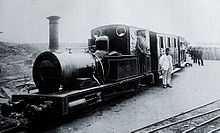Dolgoch (locomotive)
| Dolgoch | |
|---|---|
 Dolgoch at Tywyn Wharf in 2006 | |
| Specifications | |
| Power type | steam |
| Builder | Fletcher, Jennings & Co. |
| Serial number | 63 |
| Model | Class Bb |
| Build date | 1866 |
| Total produced | 1 |
| Configuration | 0-4-0 WT |
| Gauge | 2 ft 3 in (686 mm) |
| Driver diameter | 2 ft 3 in (686 mm), formerly 2 ft 4 in (711 mm) |
| Wheelbase | 6 ft 6 in (1.98 m) |
| Length | 17 ft 5 in (5.31 m) |
| Locomotive weight | 10 tons |
| Boiler pressure | 150 lbf/in2 (1,030 kPa) |
| Cylinders | Two, outside |
| Cylinder size | 75⁄8 in x 16 in (193 mm × 406 mm) |
| Tractive effort | 4,100 lbf (18.24 kN) |
| Career | |



Dolgoch is a narrow gauge 0-4-0 well tank steam locomotive. It was built by Fletcher, Jennings & Co. in 1866 and is one of the oldest locomotives still in active service. It was delivered to the Talyllyn Railway in 1866[1] and continues to run on this railway.
The fictional Rheneas in The Railway Series by the Rev. W. Awdry was based on this engine.
Design
The design is unusual for a 0-4-0. The well tank engine has a long wheelbase and the driving axle is behind the firebox, which prevents the use of a conventional valve gear layout. Consequently, the Allan valve gear is driven from the leading coupled axle and doubled back to connect to the valve rods.
The engine was renamed "Pretoria" between about 1900 and 1914 in celebration of the relief of the township of Pretoria in South Africa by Lord Roberts during the Boer war. It then reverted to the original name "Dolgoch", which it retains to this day. It is likely that, in the top left photograph, the engine carries the name "Pretoria" - the freshly painted appearance hints that this photograph was taken after the repainting and name change (records indicate it was repainted and renamed around 1900[1], and would have been a bit paint-weary prior to that. Zoom in on the high resolution picture option and you can just make out very faintly ".....ria" painted on the boiler side between the chimney and the side coal bunker). For most of the Railway's life, engine names were painted only on one side of the engines - the North side (the side facing the station platforms which were also only on this side for the whole line). Polished brass nameplates are a feature of current preservation.
References
- ↑ Boyd 1988
Bibliography
| Wikimedia Commons has media related to Dolgoch. |
- Boyd, James I.C. (1988). The Talyllyn Railway. WildSwan Publications. ISBN 0906867460.
| |||||||||||||||||||
